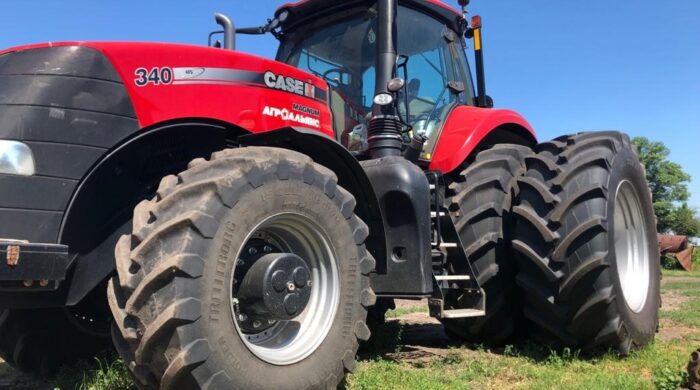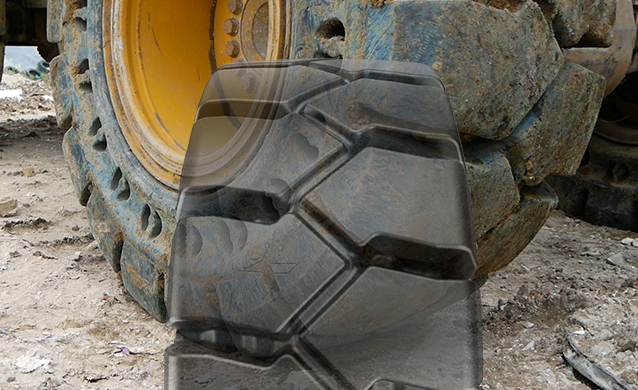MAXAM on Traction vs Flotation Optimization
AG Technical Bulletin – What is the difference between traction and flotation, recommendation on how to optimize each, and how to use flat plate as a tool?
In any application that uses a pneumatic tire to act as the interface between the vehicle chassis and the ground, the key to successfully transmitting the force necessary to move in any direction is the application of the tire’s traction capability to deliver the torque or engine power, and the tire’s ability to float or carry the vehicle load at the necessary ground pressure to remain mobile. Traction is the term used to explain how a tire overcomes the friction between the surface of the rubber tire and the ground. Friction is the resisting force that resists or acts against the relative motion of two surfaces. In other words, when a vehicle operates down the road, the vehicle engine generates the force or torque that pushes the vehicle’s wheels or tires forward and overcomes the friction between the tire surface area and the road surface area. In summary, traction is the friction generated between the tire and the road or field surface.
Flotation is the ability of a tire to stay on the surface of soft ground, soil, or snow without rutting or digging into the surface or ground thus limiting the tire from overcoming the friction of providing traction. In agricultural applications, tires are designed to deliver the optimal traction or flotation based on their size, load capability, and compounding. Ag tires are specifically sized to fit the wheelbase of the vehicle chassis. Vehicle manufacturers choose the tire size that will provide their chassis design the optimal compromise between traction and flotation necessary for the tire to successfully overcome the surface friction to deliver the torque or mobility desired. In all cases, assuming the right tire size has been chosen, the key to delivering the best possible traction or force to overcome friction is the air pressure for a given load. When operating with a tractor in the field the coefficient of traction is measured by the “slip” of the tires as they roll through a field or road. Ag tires will use higher air pressure when operating on the road and lower air pressure when operating in the field. Here are some general rules that affect the ability of the tire to deliver traction:
If you work the field at the higher road inflation pressures:
- You will have a higher tire slip.
- Tires will float less creating higher compaction.
- You will experience higher fuel consumption.
- Resulting in lower traction.
- Reduced work rate.
- Resulting in lower efficiency.
If you road the tractor at the lower field inflation pressures:
- You will have less slip but higher rolling resistance or tire friction
- You will have higher fuel consumption.
- You will have a higher tire wear rate.
- The tires will provide less ride comfort.
- The tire will less or lower lateral stability.
- Resulting in lower efficiency.
In all cases, the optimum air pressure adjusted for the weight or load, and field condition (roading vs fieldwork) will ensure that the tire delivers the best possible traction and flotation.
An Ag tire’s optimal air pressure also dictates how the tire construction or tread will provide improved or reduced flotation by extending or reducing the length of the tire footprint as provided below:

Tire traction is always improved when using the right air pressure for a given application. The vehicles slip meter will help the operator or grower determine the best possible air solution for their tires:
If tire slip is too high:
- Check that tire inflations may be high.
- Verify the load distribution from front to rear.
- Add tire ballast or weights as required.
- Optimize or adjust the working depth of any towed implement
If tire slip is too low:
- Check that tire inflations may be too low.
- Verify the load distribution from front to rear.
- Remove tire ballast or weights as required.
- Optimize or adjust the working depth of any towed implement
MAXAM provides in our Ag Tire Catalog our Tires Gross Flat Plate (GFP) which is defined in the Ag Talk Glossary as: “is the surface area of a tire in contact with the ground”. The purpose of the Gross Flat Plate is to determine the ground contact patch or measured area in square inches or centimeters that at the chosen tire tread face or surface area will provide for a given load. As you increase or decrease tire air pressure the Gross Flat Plate will increase or decrease. MAXAM provides a GFP in our catalogs based on our tires operating at 5 mph with 15 PSI or 1 Bar of Air Pressure as the initial tire footprint to assist growers in determining their ground contact patch or pressure. MAXAM Ag tires are designed to deliver an optimized footprint ensuring the best possible traction and flotation for the grower’s vehicle needs. MAXAM’s Agrixtra tread design ensures high levels of traction in field applications as well as improved grip in road applications while ensuring a long tire life. The Agrixtra R1W tread depth, with 45-Degree asymmetric lug design, coupled with the optimized inter-lug area and the reinforced lug base ensures good footprint pressure distribution delivering both superior traction and flotation. These design features ensure that our tires provide great ride comfort, low noise levels, and are also resistant to punctures or damages. MAXAM’s Agrixtra family of tires delivers a performance solution tailored for the Ag Industry.
For additional information, contact your local representative or visit us at maxamtire.com.



